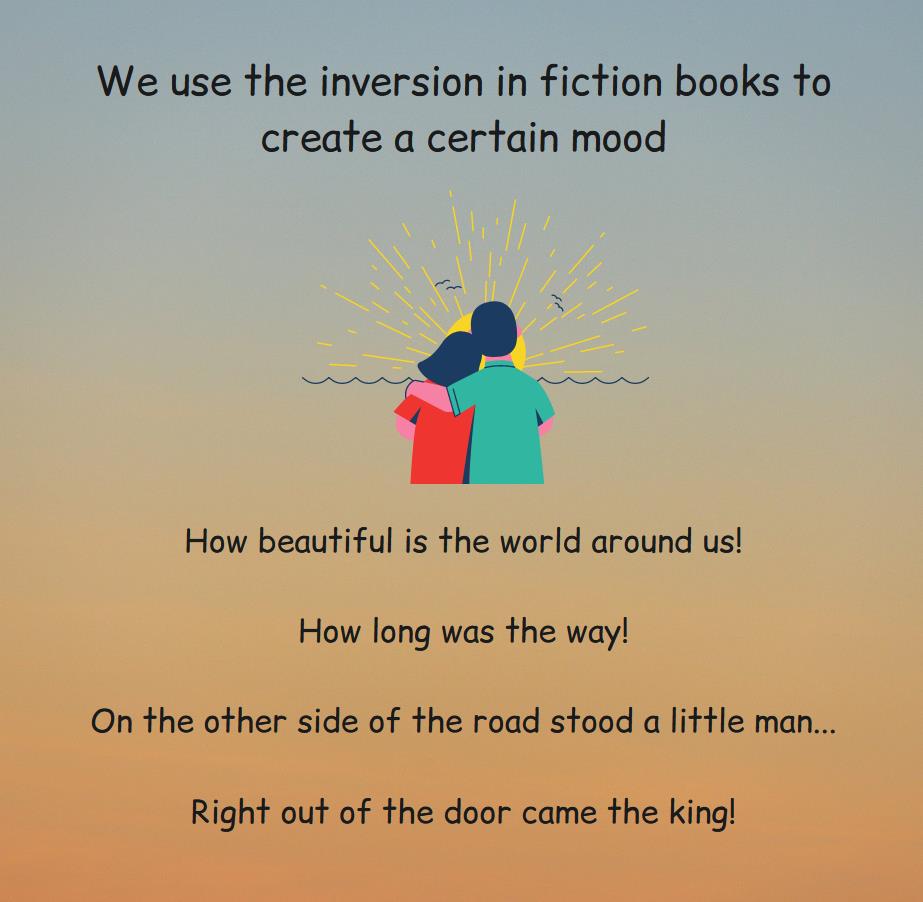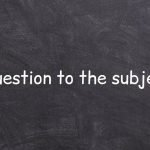What is Inversion?
The Inversion of words in English is the case when we deliberately change or break the direct word order.
There are two main word orders in English:
- Direct word order.
- inversion.
Direct word order is when the SUBJECT comes first and then the PREDICATE.
I (subject) like (predicate) apples.
In that house lived (predicate) lots of extraordinary people (subject).
The Inversion is when the Predicted can stand in front of the Subject.

Inversion as a Technique for Creating an Emotional Tone of a Word
The Inversion allows us to put an emotional emphasis on a word.
In order to make such an emphasis, we must move such a word or phrase to the beginning of the sentence. Then we apply the inversion to the rest of the sentence. That is, we put the subject after the predicate.
What we focus on – Predicate – Subject
In that car were sitting two crummy men.
Why Do You Need Inversion Of Words In Sentence?
We intentionally use the inversion by changing the order of words in order to emphasize a certain word in a sentence.
Let’s take a look at the main cases when we use the inversion in English.
Inversion With “There Is” And “There Are”
There is and there are are two extremely useful phrases in English. But sentences with these phrases have an unusual order.
We use there is and there are when we say that something is somewhere or something is not somewhere.
Take a look at this picture:

Describing this picture, we can use there is and say:
There is a book on the table.
This is a simple construction that consists of:
there + to be
If we are talking about something in the singular, we use the form of the verb to be is. If we are talking about multiple objects, we use are:
There is a big car in the park.
There are big cars in the park.
English beginners are often afraid to use this form because it sounds strange and difficult in their native language. But in English, the phrases there is or there are sound completely natural and correct. Take a look at the examples:
There is a book on the table.
There is some sugar in the jar.
Look, there are some boys playing with a ball!
The word order for an affirmative sentence with the phrase there is and there are is very simple:
- There is / There are
- The Object or Person we are talking about.
- The place we are talking about.
There are lots of sweets in her room!
There are so many cars outside the house.
The word order for an interrogative sentence with there is and there are is also very simple. We just put to be first before there.
- Is there / Are there
- The Object or Person we are talking about.
- The place we are talking about.
Is there a book on the table?
Is there a mouse in my shoe ?!
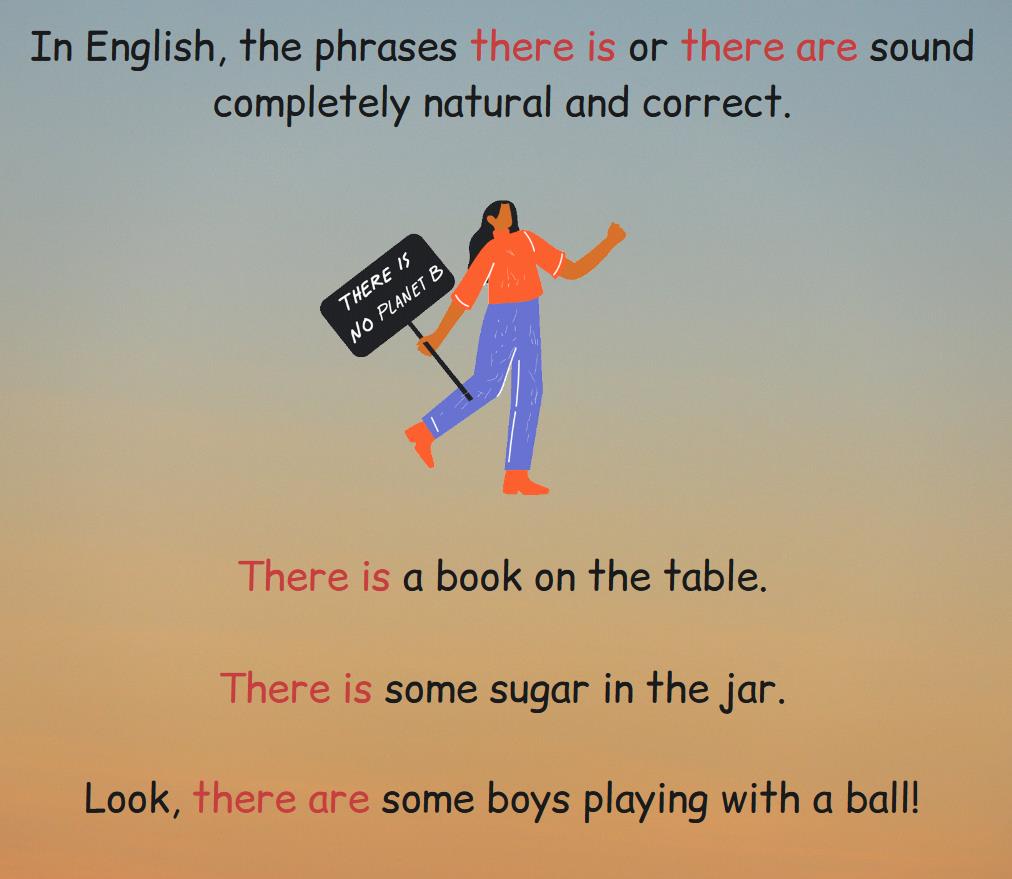
Inversion After Direct Speech
Usually, when we want to retell that someone said something, we use direct word order:
John said he loves you.
But when we convey the words of another person using direct speech, we use the inversion.
“I love you,” said John.
In such cases, we use the inversion to emphasize the words rather than who said them.
This technique is very often used in fiction books.
“Well done,” said John.
“I will not go with you, I do not know you,” objected the woman.
“Help your brother,” ordered my father.
That is, we put the words that the person said at the beginning, and then we indicate the one who said it. In this case, we can indicate the person in two ways:
“Well done,” said John.
“Well done,” John said.
In what order we put “John said/said John” is not important. In these examples, you should first of all pay attention to the fact that the inversion occurs in the main part of the sentence. The speaker’s words are at the beginning. The one who speaks stands after them.
But if the speaker is indicated by a pronoun, then we use only this order:
pronoun -> said
“I don’t like you,” he said.
“Take me with you!” she exclaimed.
“Beep-beep-beep,” it squeaked.
If in direct speech we use a question, then the verb ask and the object in which we indicate who exactly asked this question, then we use only direct word order.
Correct: “Where is my car?” the guy asked the policeman.
Incorrect: “Where is my car?” asked the guy the policeman.
If you look closely at the wrong example, you can see why it is wrong. If we write “asked the guy the policeman” we get confused and it is not clear who asks and who is asked.
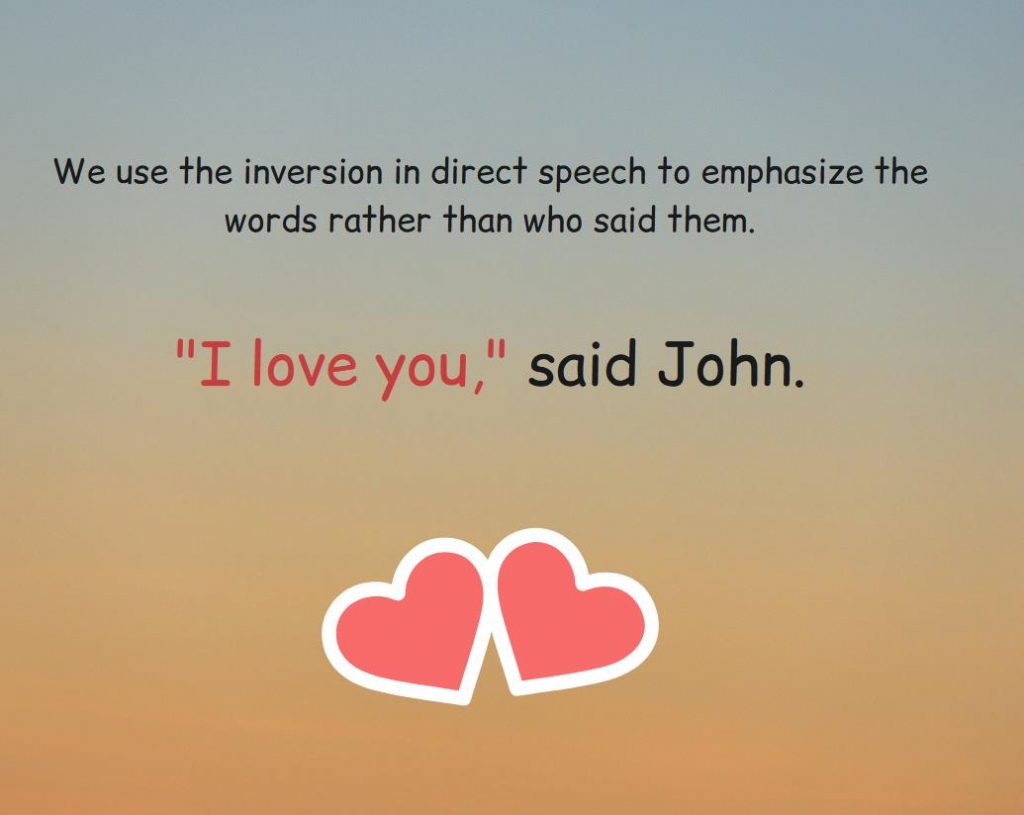
Construction With Words Here And There
The following construction is suitable in spoken English and informal writing. This is a construct with the words here or there. We also use the inversion in this construction.
Here goes the shy blushing bride.
Here comes my dad and a baby carriage.
Here goes something, something exciting …
Here comes the woman you’re meeting.
Here goes John!
Note the word order in the examples above. Why are we doing this inversion? Because we want to focus not on a verb, but on the place where an action takes place. When we say:
Here goes John!
We focus on the location of the action, on the fact that it happens exactly here or there.
Look at other similar examples and notice the emphasis that is not on the verb but on the scene.
Here she lies in all her beauty.
There is some truth to that.
Here he comes, Mr. Jeff.
There are things we cannot change.
There goes our chance for survival.
Here she shall do what she likes.
There are joys hidden in every moment.
Here we go, guys!
There goes your queen!

Inversion In Conditional Clauses With Was, Were, Had, Could, Should
We use the inversion in conditional sentences with the verbs:
- was
- were
- had
- could
- should
Should she be given another chance, he would do her best.
Had I realized this, I would’ve stopped him.
Should he be the highest in the land, I’ll find him.
Should I need instruction, I shall ask.
Let’s take a closer look at this inversion case.
Conditionals consist of two parts with a condition (if) and a result.
If I was a policeman (condition) I would ask questions (result).
We can do the inversion in the part that contains the condition.
We can apply the inversion to all types of conditional clauses:
- The First Conditional
- The Second Conditional
- The Third conditional
Take a look at examples:
If I had a family, I’d do anything to protect them.
Had I a family, I’d do anything to protect them.If you had a car, you could stop by Colorado and pick me up.
Had you a car, you could stop by Colorado and pick me up.If you could do that right now, I think it would be very encouraging.
Could you do that right now, I think it would be very encouraging.If you should need me, just call me whenever you like!
Should you need me, just call me whenever you like!If you lived here, you’d be home already.
Were you to live here, you’d be home already.

Inversion And Adverbs Of Movement
We can use the inversion in sentences in which we use adverbs of movement and motion verbs.
Motion verbs are verbs such as:
- Run
- Walk
- Jog
- Dart
- Roll
- Spin
- Fly
We use the inversion in such cases because we want to focus not on the verb but on the direction.
To understand this better, first look at an example without the inversion:
The bird flew across the sky.
There is no inversion in this example. We used the usual word order. We see that the main character (The bird) takes the action (flew). This is what is emphasized in this example.
But what if we want to shift the emphasis from the object that performs the action and the action itself to the place where this action takes place? Right! We use the inversion:
Across the sky flew the bird.
Having written this sentence using the inversion, we made the main emphasis on the direction in which this action is taking place.
Down the slope descended a flock of sheep and a shepherd.
Inversion In Complex Sentences
We use the inversion in complex sentences that begin with words such as:
- hardly
- scarcely
- no sooner
- never
- nothing
- not only
These words create a strong emotional background for the entire sentence. Therefore, after such words, we sometimes use the inversion.
Hardly had I opened the door when he told me.
Hardly had I seen her for the first time I knew this is love!
Never had I felt so alive than when I was so close to death.
Never had I met a lady so graceful, so charming.
Hardly had he recovered from cold when he was hit by a car
No sooner had you got married than you began to regret it.

Also, using similar expressions, we emphasize that the action from the second part of the sentence began earlier than we expected.
To emphasize this nuance, we use the inversion in the first part of the sentence.
We also do this inversion trick after adverbs that have a negative meaning. These are, for example:
- barely
- scarcely
- seldom
- hardly
- rarely
Take a look at the examples:
Seldom did he asked for help.
Rarely do I work until evening.
Rarely did she think about her family.
Hardly was I there when she called me again crying for help.
Scarcely had I started out when it began to rain.
As you can see in these sentences, we did the inversion again in order to show that the action came earlier than we expected. But in this case, this surprise has a negative meaning.

Additional Cases Of Inversion In English
In addition to the main cases of using the inversion, there are many more cases and nuances in English.
After The Words As And Than
We use the words as and than when we compare something or show the superiority of one thing over something else. For example:
This ball is bigger than that ball.
I’m not as hardworking as your father.
With the help of the inversion, we further emphasize the comparison or superiority of one object over another.
Perhaps they speak perfect English, as do we.
I know you care for her deeply, as do I.
They are the key doers, as was indicated.
Most countries in Central America also have young populations, as do Bolivia and Paraguay.
Today we live together as was never possible before.
After Never And Nowhere
We use the inversion after never and nowhere to emphasize that what we are talking about has never really happened before.
Never had I this problem with him.
Never had we the chance to fight for them.
Never could she sit still long enough for it.
Never had we a letter from him.
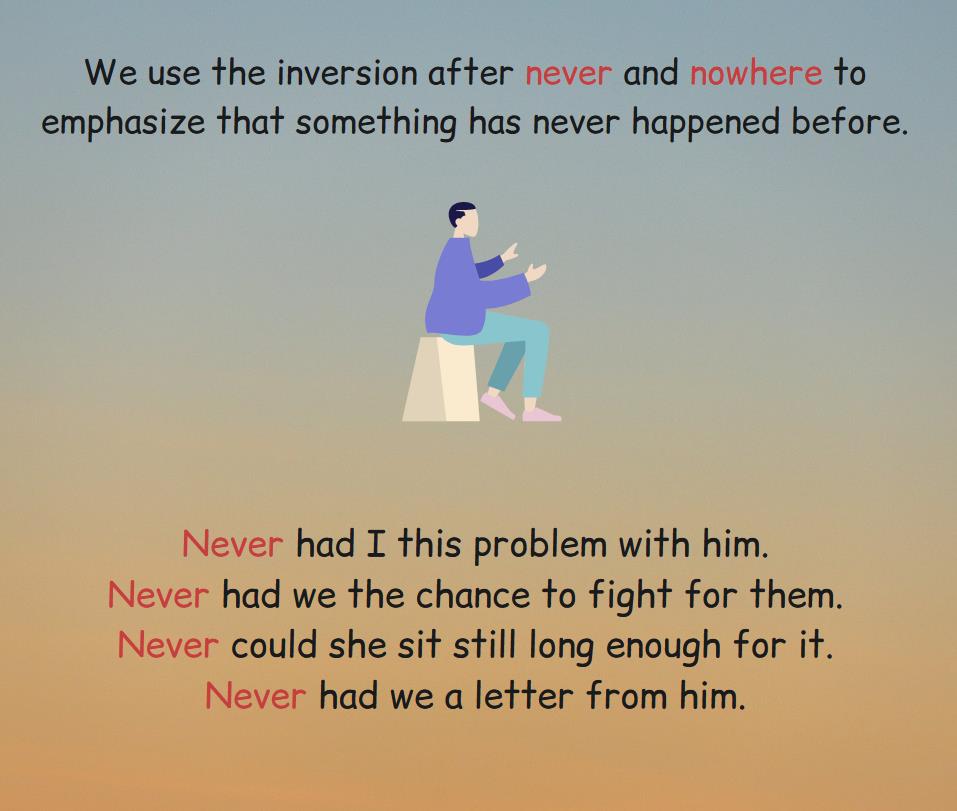
After Little
The word little not only helps us to characterize the size or volume of something but also carries a rather strong emotional meaning.
If we use the word little in a sentence with inverted word order, then the word little acquires an additional meaning.
Little did they know that they were tricked.
Little did I expect that he would meet such a fate.
Little had he understand what to do with all the money.
In sentences with the word little and the inversion, we often use words such as:
- know
- understand
- notice
- recognize
- admit
- think
- see
- expect
After Adjectives And Participles
We do the inversion after adjectives and participles in a sentence in order to focus on the part in which we describe something or someone.
First, look at this common sentence:
The night was quiet.
In this sentence, we describe the night with the word quiet. It looks like a usual sentence. But, now, let’s put an emotional emphasis. For this, we will use inversion.
Quiet was the night.
After we applied the inversion, we moved the focus to the emotional part.
After The Word Such
We use the inversion to shift the emphasis on the emotions that are conveyed by the words such + noun.
Such was the case yesterday; it still is today.
Such is the plight of young, be in the shadow of a senior.
Such was the beginning of his march to later successes.
Such was their power, they began to outgrow the earth and destroy it.
Such are the challenges confronting those who are small and weak, yet proud.
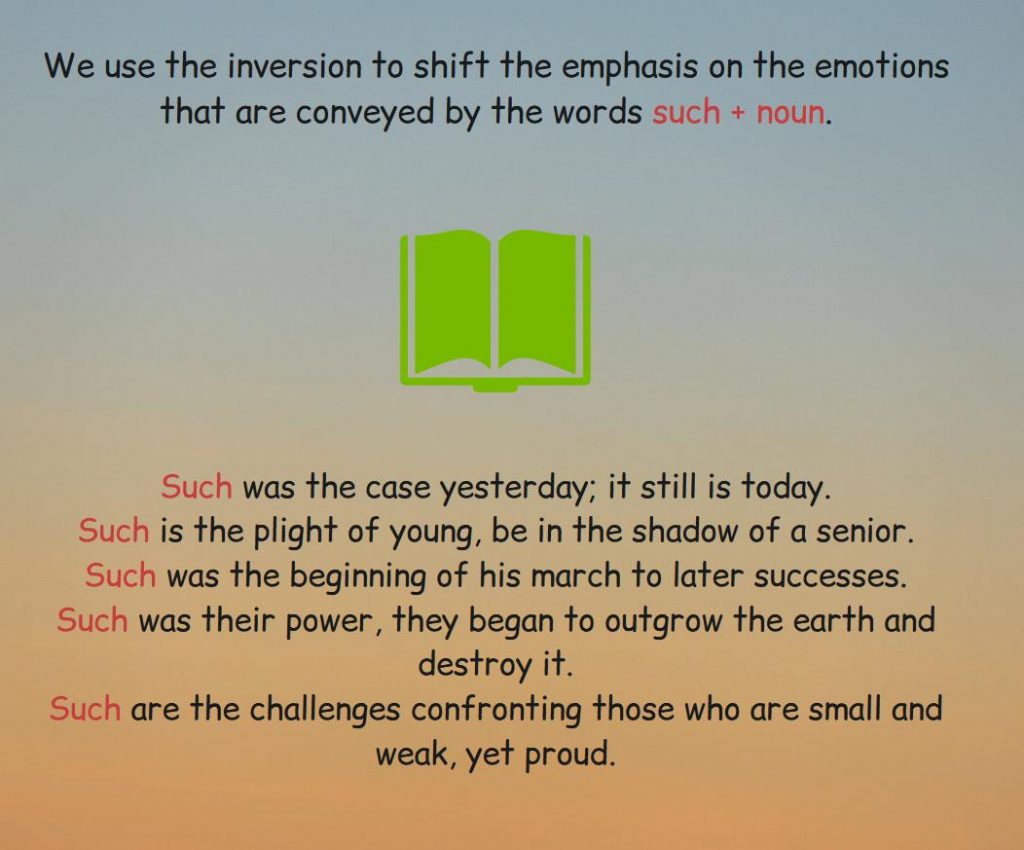
Inversion With Had It Not Been For …, Would Have + V3
The construction Had it not been for …, would have + V3 (and some combinations of this construction) helps us to express our attitude to some event that happened in the past and the result or other event that was a consequence of the first event.
In this case, we are trying to express the fact that the second event happened precisely because the first event happened. And we express our reactions and our emotions about it.
This explanation probably sounds complicated and confusing, so let’s quickly look at an example:
Had it not been such, I would not be who I am.
Had it not been for my son, I would not have been there.
Had it not stopped turning, I would not have found it.
NOTE: In the second part of similar sentences, you can use both affirmation and negation. It depends on what exactly you want to say. But the first part of such a sentence is always negative “Had it not …”
After So + Adjective
Such sentences start with the word so and an adjective that describes the object we are talking about.
In this case, we do the inversion in order to emphasize the emotions that we convey with the help of this construction.
Look at examples of such inverted sentences:
So strange was the place we were in.
So amazing looked that woman I gasped.
So nasty were those men standing before us.
Inversion In Sentences With Neither, Nor
We use the words neither and nor to make a negative agreement with the interlocutor.
For example, John and Max are watching a movie. John doesn’t like this movie. So John says:
I don’t like this movie.
Max doesn’t like this movie either and wants to “agree” with what John said. To agree with something that has a negative meaning, we use words like neither or nor. We use the inversion in sentences with these words.
I haven’t seen a doctor in ten years. – Nor have I.
I have never looked at anyone that way before! – Nor have I.
I know you don’t like it, nor do I like being asked to wait.
The captain no longer controls the ship but neither do we control it.
Your dad doesn’t need us anymore and neither do we need him.
Inversion In Sentences With The Word “So” When We Agree With Someone
This case is very similar to the previous case. The difference is that we use so when we agree with something that would be said to be a positive affirmation.
I like this book! – So do I!
My sister likes melons and so do I.
He knows how to use a sword and so do I.
Inversion In Sentences With The Modal Verb May
In English, there is one interesting way to form an exclamation clause that begins with the verb may followed by the inversion. We use such sentences in a positive way.
May your blade be chip and shatter.
May your kids be happy and fat.
May he or she grow up in a less complicated world.
May she never lose his country again.
May all my enemies turn to ash.

Inversion After Adverbs Of Place
We use the word inversion after adverbs of place.
What if we want to say that there is something in a certain place? We use the verb to be. But what if at the same time we want to replace the verb to be with some other verb that expresses an action? In this case, we form a sentence with the inversion:
- A place.
- Predicate (Verb).
- Subject (Who or what performs the action).
Such a sentence would look like this:
On the wall hung an old painting.
In the garden sit a beautiful woman.
Inversion In Exclamatory Sentence
Exclamatory sentences are sentences in which the main goal of the speaker is to express some kind of emotion.
We do the inversion in order to emphasize the emotional part of such sentences.
We use this technique especially often in informal everyday speech.
Look at the examples of exclamatory sentences with the inversion:
Oh, am I glad to see you!
Oh hell, were they scared!
In Expressions With The Word “Not”
There are sentences in the English language, where we use the inversion to reinforce the negative meaning of not. Take a look at examples:
Not until that time did they know what to do.
Not for the first time was I afraid.
Not a single sound did they hear.

Inversion With Combination Not Only … But Also
We use a combination of not only … but also to emphasize two actions. In this case, the inversion helps us to amplify emotion.
Not only can you get banned, if caught, but also you could be charged.
Not only could this car drive on snow, but it also mastered it.
Not only did he meet up with Dad, but also they were chatting for two hours.
Not only couldn’t you come, but you also don’t say when.
Inversion In Some Expressions With The Word “No”
In the English language, there are some stable expressions with the help of which we can convey an emotional denial of something or an emotional disagreement with something.
The inversion in these stable expressions emphasizes the negative meaning of the word no.
Under no circumstances can that contract become public knowledge.
Under no circumstances are you to be granted those privileges.
In no way did the officer mislead anyone.
At no time was she discussed with me anything on this topic, I swear!
After Time Clauses + Only
If we use the word only + time, we can use the inversion to reinforce the meaning of the word only.
Only after the job is done will we be free.
Only when I got there, did I understand the plan.
Inversion As A Tool In Fiction
You can find the inversion in fiction books. In this case, the inversion is used as a tool to create an emphasis on the place where something or someone is.
In this case, the inversion gives a certain romantic flavor to such sentences.
How beautiful is the world around us!
How long was the way!
On the other side of the road stood a little man…
Right out of the door came the king!
